|
|
|
As mentioned earlier there two ways to generate RF energy, short circuit a charged capacitor or open the circuit of an inductor with a field. We shall examine the inductor case first. If an inductor has a current flowing through it and something breaks the circuit, RF energy will spring forth. The amperage will not stop all at once. When a capacitor is full of charge it cannot discharge all at once. The attempt to do so also causes RF energy to spring forth.
RF energy comes out of a wire or circuit when the EMF gets separated from the electron charge carrier. The RF energy emerging is the transconductance energy that has been interrupted by a switch opening for an inductor. For a capacitor RF energy emerging is the magnetic charge energy that has been stripped away from the electron as that electron gets used to open a transconductance corridor for other electrons to use. These three sentences are probably hard to make sense of. Before following the trail of discovery to the examples that make this understandable we need to review a few basics again.
In this experiment we will add the external static electric charge on the outside of the pipes to the list if things to consider. To help understand what the electricity is doing we will stop and review what comes to mind for most people when the term static electricity is mentioned. This is only for mental imagery purposes and is not to be confused with actual technical descriptions. Most people are aware of static electricity due to discharges caused by rugs and upholstery. That is not the mental image that you want. That is static discharge. Static charge is before that. It is when hair stands on end like tentacles. It is when you reach toward an ash tray and all the ashes jump out of it just because your hand got near. It is when you get that glow in the dark feeling caused by electricity. That is the mental image you want for static electric charge.
An electron is a unit of static electricity. The static part means it can't move. It doesn't. "But don't they orbit in atoms and flow in wires ?" you might ask. No, they don't. They spin but they don't move. The direction of the spin separates it from the protons which spin the opposite direction When the electrons appear to move they are actually disintegrating on the back side, flowing around its stationary self as magnetic energy, and then reintegrating into a new front side of a new position. See figure 5a. When the stuff called charge moves it is magnetic energy. It is the 'cylindrical flywheel' where 'moving' static electron energy is stored. When a free electron impacts a surface it ceases to re integrate in a forward direction. The magnetic flywheel energy is redirected or absorbed.
What is a transconductance channel ? It is a part of the magnetic tube created when a string of electrons flow. See figure 5c. The magnetic fields of each electron in 'motion' join together. When they join together they pull themselves together even more due to similar magnetic fields. As that happens a small amount of EMF energy from the magnetic charges gets displaced. That EMF energy becomes the transconductance corridor. This event is similar to the Masa Energy Defect explained in the next paragraph. The following EMF energy flows through the magnetic field surrounding the static electrons. When static charge energy used to create the magnetic tube it becomes inductive energy. That exact amount of energy is returned somewhere somehow whenever the field collapses. If the field is around a coil it will return the energy as electric current. If not allowed to do so by a transistor the EMF which is in the magnetic field will produce static charge energy at the point of interruption. This is the RF energy emerging as static charge energy. That static charge begins to disperse from its concentration. As soon as it 'moves' it becomes magnetic energy again. It is free to leave the circuit because it is no longer bound to the EMF source that it came from. The EMF energy got disconnected from the battery by the coil and then redirected to leave the circuit by the transistor. The transconductance effect just illustrated by electrons flowing in a wire is the same effect that lowered the resistance of the wire in the inductive pickup mentioned earlier. It is the same effect that will allow the RF energy to leave the antenna later.
The Mass Energy Defect is a peculiar thing that happens when a proton and an electron get together to form an atom. The sum of the weights of an electron and a proton is less that the weight of the atom that they make when combined. The missing mass shows up as the energy that the electron has because it is in orbit. The attraction between the proton and the electron has pulled them together. They cannot merely combine because the charge energy between them cannot be destroyed. Therefore, the electron ends up in orbit to consume that energy as inertia. This is what is called a quantum state. The electron cannot orbit lower because if it did its inertial energy would be less than required. This is the ground state. Higher quantum states are possible if more energy is added. When that happens the electron goes to a higher orbit. Eventually it will discharge a photon of energy and return to its groung state. The loss of mass to form orbital energy is similar to the loss of EMF that the static charge loses to form the magnetic transconductance corridor.
When the air in a spark gap breaks down and conducts, a magnetic corridor and a transconductance corridor have been established from static electron charge energy driven by the EMF. The magnetic charges that were on the electrons used to make the corridor with become separated from the electrons that they were a associated with. At that point they are free magnetic charge energy. They are EMF that has been separated from the electron charge carriers which got used for the corridor. Those free magnetic charges are now RF energy from a capacitive source. Now they travel outside the wire and are referred to as RF amperage even though there are no electrons involved. They have a sinusoidal rise and fall time and a wave length. Now they are in a magnetic charge energy wave form instead of static electron charge unit form. It is still the exact same electricity as it was inside the wire. The static charge has turned into a transconductance corridor and shed its magnetic field as RF magnetic energy.
To understand RF energy conversion from AC or DC to RF is a bit tricky because the two methods for doing it are like opposites of each other. The capacitive method converts EMF to RF when the transconductance corridor is established. The method is based on voltage changes which then produce magnetic RF waves. The inductive method converts EMF to RF when the transconductance corridor is collapsed. It is based on amperage changes which then produce RF voltage waves. See figure 9. The methods are so exactly opposite of each other that they helped figure each other out by determining opposite conditions of those that were known. The inductive method is easier to study first because it has its magnetic field in the coil where you think you understand it.
A capacitor full of electrons has no magnetic field. It has EMF in the form of compressed static charge. A magnet has no electric field. It has EMF in the form of compressed magnetic charge. The EMF in the magnet field is bound to the atom it originates from by something called the Mass Energy Defect. The EMF in the capacitor is readily available to be released by the electrostatically compressed capacitor media. The electrical equivalent of a magnet is the coil of wire. The coil of wire turns EMF driven static electron charge into a magnetic charge channel. As soon as it is formed the channel collapses on itself slightly for form the transconductance corridor. Then DC magnetic field current that flows through just keeps the corridor supported. The strength of the magnetic field outside is equal to the magnitude of the static charge used to create the magnetic channel inside. It is not related to the cumulative energy used by the coil. The magnetic charge thus created cannot leave the coil of wire for the same reasons that it cannot leave an atom. It is a part of the wires atomic energy structure. The atom will not let go of it. It is only out of place, in the form of a field, because the EMF causing the current flow creates a internal magnetic corridor to do so. That corridor displaces the electric charge inside the wire which attempts to leave the wire as magnetic charge
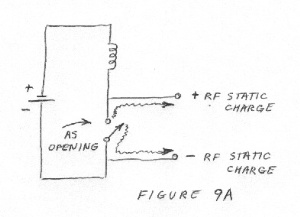
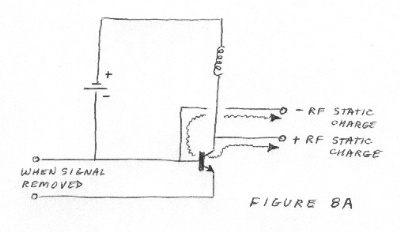
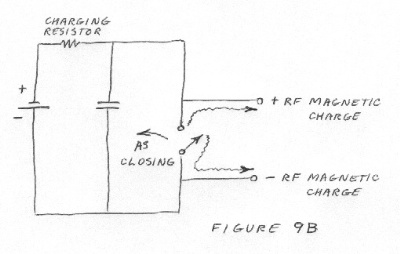
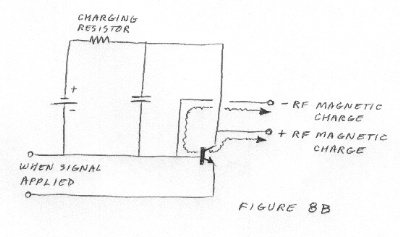
Look at figure 8a. It is a coil in series with a transistor ( or any switch device ). When the transistor tries to shut off the current it cannot stop the current flow instantly. The speed that it can stop the current flow is the speed at which the blocked magnetic field collapse causes static charge build up at the interruption point. Note that the transistor is part of the entire magnetic circuit. The break of the magnetic current flow and the transconductance corridor are caused at that point. The magnetic energy stored in the coil will choose both sides of that break to vent its collapsing field as static charge. The collapsing field is the source for the EMF that goes out into the RF wave. Some EMF energy from the battery has been relocated to the coil and then ejected as static charge with its own EMF included. This is one of the two voltage phases of an RF wave. A push-pull power source is required to power both phases of a RF wave.
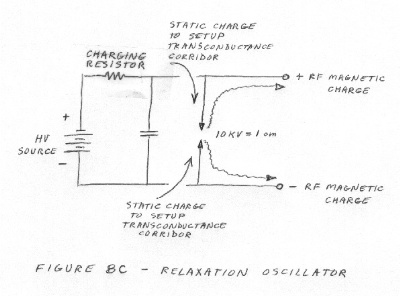
Look at figure 8c. It is a capacitor in parallel with a spark gap ( or any switch device ). When the spark gap gets to the voltage breakdown point it begins conducting. The transconductance corridor that becomes the path for electrons to 'flow' across the gap is created from static electron charge energy. That energy comes directly from the power source EMF when it charges the system up with its presence. When the corridor collapses the energy is returned to the circuit as inductive field collapse energy. When the 'moving' electron gets used as construction material for the transconductance magnetic corridor it abandons whatever magnetic charge it had. Only the electron crosses the gap with its static charge energy value. The additional energy that it had in the form of magnetic charge energy got abandoned at the beginning of the magnetic corridor ( the gap ). That abandoned magnetic charge energy is now RF 'amperage'. It is magnetic charge flow but there are no electrons involved. It is its own EMF. It collapses by moving. As soon as it moves it causes static charges to build up. The magnetic charge loses its energy as it converts to static charge. Some EMF energy from the battery has been relocated to an electron as magnetic field. The EMF caused that electron to become a magnetic corridor itself. The original magnetic field energy became free to travel. It traveled in the only way it could as an RF wave. Magnetic charge energy is not the same as magnetic field energy. See figure 10. A magnetic field is magnetic charge energy that cannot leave the EMF that caused it to be displaced from the metal atoms in the wire. When a magnetic field gives up energy the energy comes directly from the EMF source as additional amperage and uses the magnetic field energy as a linkage. When magnetic field energy gives up its energy it is because it is collapsing and turning to static charge energy or because it is being absorbed by a conductor and being turned to EMF for a new circuit.
Static charge energy is not the same as a voltage field. See figure 11. The lines of static charge go right through insulators. The lines of a voltage field cannot. Static charge lines are only affected by other charges or by conductors. If it were not so radio waves could not pass through insulators. The static charge part of RF energy is the part that 'sees' where to go. The magnetic charge is the part that follows and brings EMF energy with it.
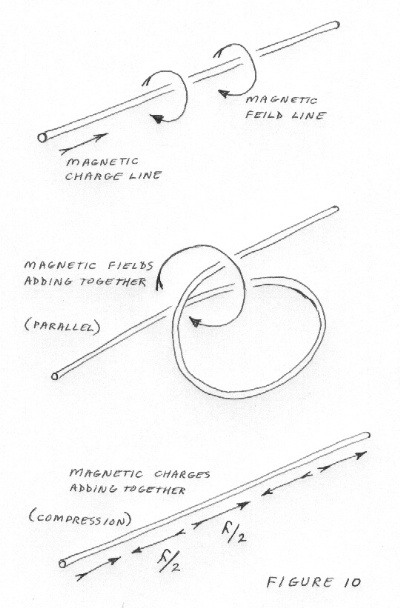
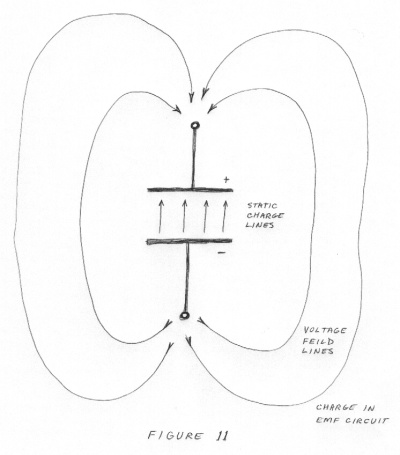
There is a fine point about both of these methods that needs more attention. The RF energy only emerges from the circuit when the transconductance corridor is either rising or collapsing. DC discharge does not radiate RF energy. Neither does AC discharge. AC energy may resonate an antenna but it does not radiate. When the magnetic field is being forced to collapse prematurely for an inductor it is the energy in the transconductance corridor that becomes the energy in the RF wave. The corridor contains (is) the excess EMF energy from magnetic charge channels 'Energy Defect'. The amount that is excess is the amount that the inductor was not finished using when it was forced to stop. When it collapses the excess static charge energy being used by magnetic charges as the transconductance corridor becomes static charge energy again. That is the emerging RF wave.
When the corridor is rising for a capacitor, it is the abandoned magnetic charge energy from the static electrons the corridor gets made of which then become the magnetic charge energy in the RF wave. Once the corridor is established for each constant amperage level the additional electrons do not abandon their magnetic charge as they 'flow' across the gap. The first abandoned magnetic charges are the emerging RF wave. It goes away from the static charge of the EMF that it came from.
For both methods the emerging RF wave has an EMF push behind or within it. The resulting RF waves are sinusoidal. That means that the rise time and the fall time of the RF wave is the same. Whether from electric or magnetic charge the RF waves leave with a shape like waves in a pond for roughly the same reason. The next step is to radiate from the antenna.